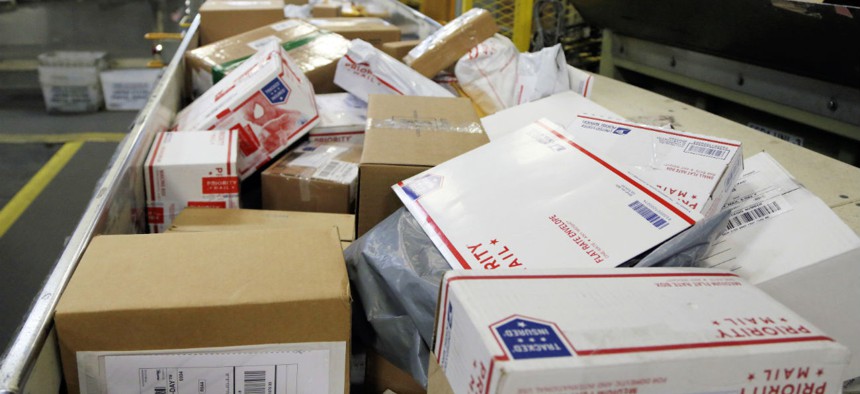
Nati Harnik / AP file photo
Postal Regulators Lay Out New Proposal to Enable Larger USPS Rate Hikes
Mailers say the new system could create uncertainty and drive customers away from the Postal Service.
The U.S. Postal Service could soon raise prices in a way that more closely follows increases in its costs, as the mailing agency’s regulators proposed an overhaul to the existing rate-setting system it has deemed inadequate.
The Postal Regulatory Commission still would not give USPS full authority to set its own prices—as agency management has requested—in its revised notice of proposed rulemaking issued on Thursday. The updated proposal follows an initial one from the commission in 2017 that found the current system tying price increases to inflation to be overly restrictive for the cash-strapped Postal Service. The commission originally suggested a static price cap of 2% above inflation, plus an additional 1% if it met certain performance metrics.
The new proposal would instead tie price caps to what PRC identified as USPS’ two biggest cost drivers: the declining density of mail and mandatory payments the agency must make toward benefits for future retirees. PRC suggested a new formula that factors in the higher costs of delivering mail in less dense areas, as well as a second formula based on the costs of mandated payments for retirees. The retiree calculation would be phased in over five years and all revenue it generated would have to go toward amortized payments into retiree funds.
Another revision from the PRC would combine the performance-based price adjustment. Instead of unlocking small adjustments by meeting various benchmarks for operational efficiency and service standards, USPS could qualify for only one performance-based adjustment of 1% if it met all of its requirements.
The commission’s rule would give USPS less wiggle room on discounts it offers to large-scale mailers who reduce the agency’s workload by pre-sorting mail. For a small collection of products for which the Postal Service's costs exceed revenue, the agency would be able to increase prices by an optional 2%.
A USPS spokesman said the agency was still reviewing the proposal. Postmaster General Megan Brennan had given the commission’s previous proposal a mixed review, applauding the regulators for noting the inadequacy of the current system but criticizing the failure to grant more autonomy to the agency.
The price review was required by the 2006 law that created the current cap structure. It was the first review since that law and the current pricing regulations went into effect. In addition to the Postal Service, stakeholders in the mailing industry offered their input to PRC. Most major organizations representing large-scale, private sector mailers urged the regulators to keep the inflation-based caps in place, saying the Postal Service was exaggerating the severity of its financial troubles.
PRC said it received a range of comments on its initial rule and its updates would “strengthen and improve” its prior proposal. The commission noted some customers would feel the pain of price increases, but it would be up to the Postal Service to strike the right balance each year.
“Individual customers and small business users of postal products and services may experience price increases above what the previous [inflation] rate authority provided due to the proposed categories of additional rate authority,” PRC said. “However, as previously mentioned, the Postal Service’s Board of Governors will continue to set prices for all products and services offered by the Postal Service. As a result, exact future prices are not known at this time.”
Stephen Kearney, president of the Alliance of Nonprofit Mailers, an industry that accounts for about 10% of USPS mail, said the new formulas for increasing prices would lead to a similar result as the initial proposal.
“We remain opposed because we think the [inflation-based] cap is not the problem,” Kearney said. “In fact, it is exactly what the Postal Service needs to survive,” as customers will migrate away from the mail if prices increase too dramatically. He added that PRC was unlawfully overruling the federal statute calling for an inflation-based cap. The new formula approach, he said, would create more uncertainty and “it’s hard to rule out the possibility of larger increases than the first proposal.”
For some customers already on the ropes, Kearney said, pointing to hard-copy periodicals as an example, this increase “could be the straw that breaks them.”
For its part, the regulatory commission said its proposal would put USPS on firmer financial footing while providing incentives for the agency to cut costs and maintain service standards.
The rule would “create a flexible, stable, predictable, and streamlined ratemaking system that ensures the Postal Service’s financial health and maintains high-quality service standards and performance,” PRC said.
Stakeholders will now have until Feb. 3, 2020, to submit comments.







